Financial Management: Analysis, Ratios and Improvement Strategies
VerifiedAdded on 2023/06/18
|13
|2920
|168
Report
AI Summary
This report provides a comprehensive analysis of financial management, covering key concepts, the importance of financial statements and ratio analysis, and strategies for improving a company's financial position. It begins by defining financial management and highlighting its importance in financial planning, decision-making, maximizing firm value, and optimizing fund utilization. The report then describes the main financial statements—balance sheet, income statement, statement of retained earnings, and cash flow statement—and their uses in financial management. A detailed ratio analysis, including profitability, liquidity, and efficiency ratios, is performed to assess a company's financial health, noting a positive trend in profitability and efficiency but a decline in liquidity. Finally, the report suggests processes, such as capital budgeting, to improve the company's liquidity position by minimizing overhead costs and improving debt collection practices. The overall aim is to provide insights into effective financial management practices for organizational success, and this assignment is available, along with other study resources, on Desklib.

Importance of Financial
Management
Management
Paraphrase This Document
Need a fresh take? Get an instant paraphrase of this document with our AI Paraphraser
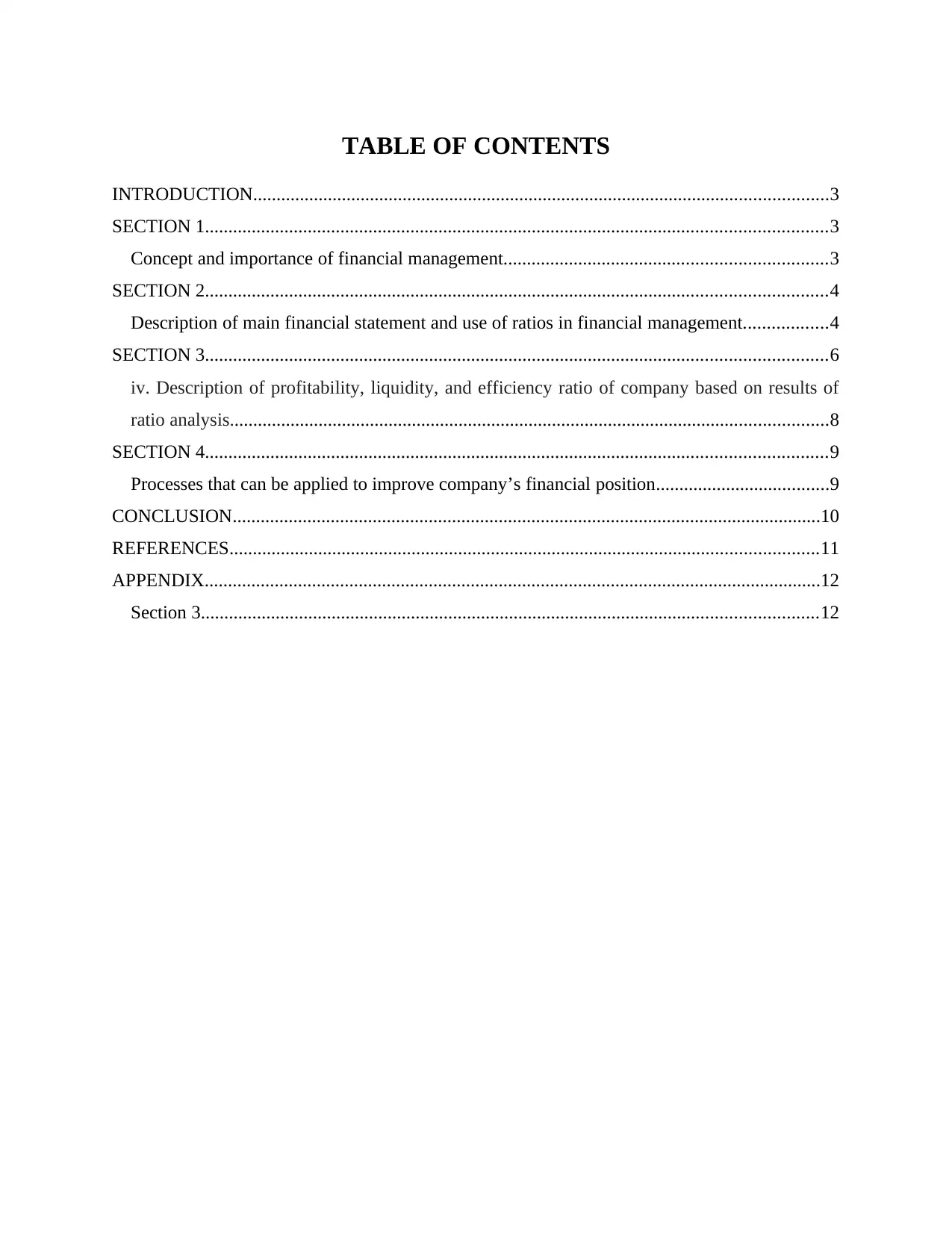
TABLE OF CONTENTS
INTRODUCTION...........................................................................................................................3
SECTION 1.....................................................................................................................................3
Concept and importance of financial management.....................................................................3
SECTION 2.....................................................................................................................................4
Description of main financial statement and use of ratios in financial management..................4
SECTION 3.....................................................................................................................................6
iv. Description of profitability, liquidity, and efficiency ratio of company based on results of
ratio analysis................................................................................................................................8
SECTION 4.....................................................................................................................................9
Processes that can be applied to improve company’s financial position.....................................9
CONCLUSION..............................................................................................................................10
REFERENCES..............................................................................................................................11
APPENDIX....................................................................................................................................12
Section 3....................................................................................................................................12
INTRODUCTION...........................................................................................................................3
SECTION 1.....................................................................................................................................3
Concept and importance of financial management.....................................................................3
SECTION 2.....................................................................................................................................4
Description of main financial statement and use of ratios in financial management..................4
SECTION 3.....................................................................................................................................6
iv. Description of profitability, liquidity, and efficiency ratio of company based on results of
ratio analysis................................................................................................................................8
SECTION 4.....................................................................................................................................9
Processes that can be applied to improve company’s financial position.....................................9
CONCLUSION..............................................................................................................................10
REFERENCES..............................................................................................................................11
APPENDIX....................................................................................................................................12
Section 3....................................................................................................................................12
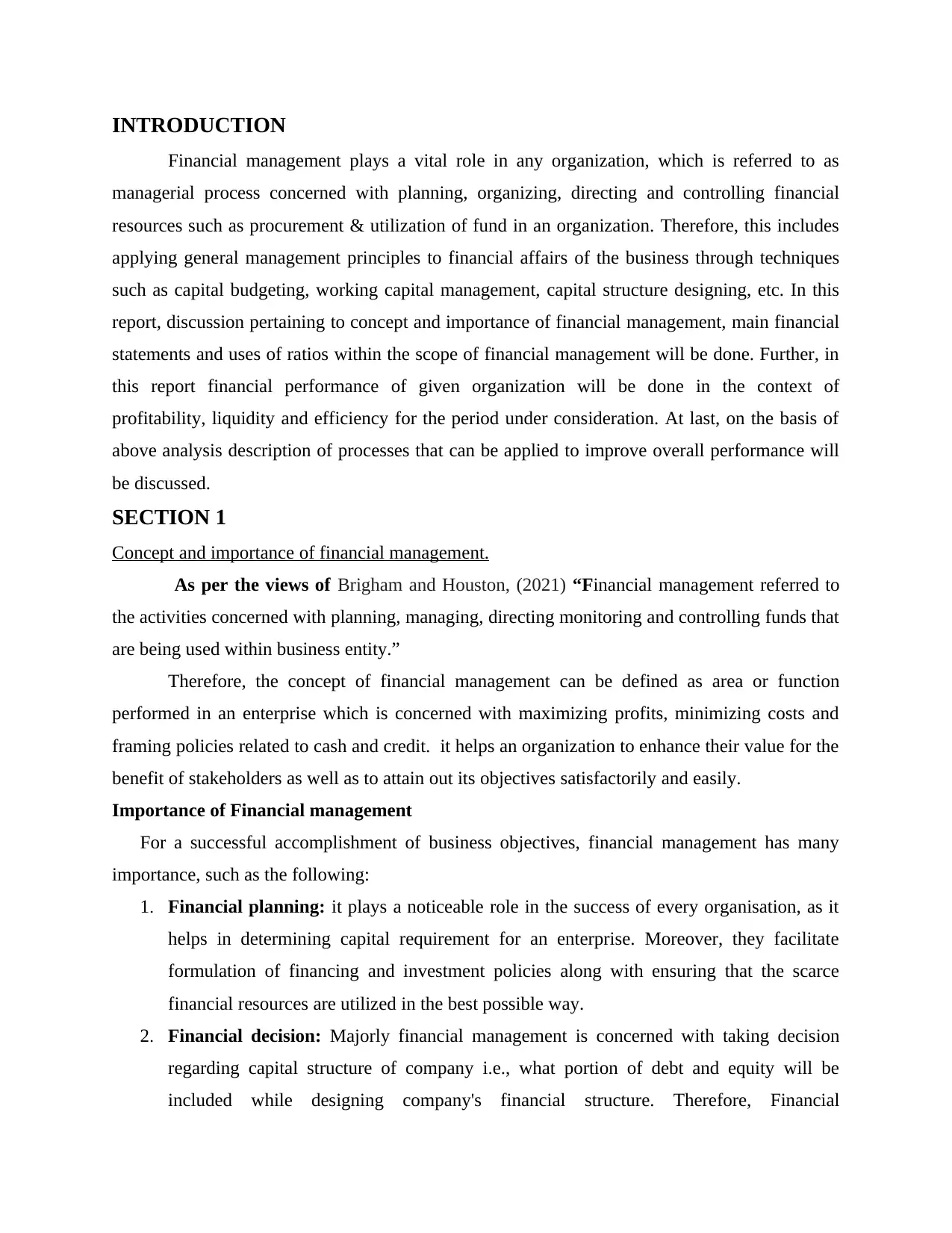
INTRODUCTION
Financial management plays a vital role in any organization, which is referred to as
managerial process concerned with planning, organizing, directing and controlling financial
resources such as procurement & utilization of fund in an organization. Therefore, this includes
applying general management principles to financial affairs of the business through techniques
such as capital budgeting, working capital management, capital structure designing, etc. In this
report, discussion pertaining to concept and importance of financial management, main financial
statements and uses of ratios within the scope of financial management will be done. Further, in
this report financial performance of given organization will be done in the context of
profitability, liquidity and efficiency for the period under consideration. At last, on the basis of
above analysis description of processes that can be applied to improve overall performance will
be discussed.
SECTION 1
Concept and importance of financial management.
As per the views of Brigham and Houston, (2021) “Financial management referred to
the activities concerned with planning, managing, directing monitoring and controlling funds that
are being used within business entity.”
Therefore, the concept of financial management can be defined as area or function
performed in an enterprise which is concerned with maximizing profits, minimizing costs and
framing policies related to cash and credit. it helps an organization to enhance their value for the
benefit of stakeholders as well as to attain out its objectives satisfactorily and easily.
Importance of Financial management
For a successful accomplishment of business objectives, financial management has many
importance, such as the following:
1. Financial planning: it plays a noticeable role in the success of every organisation, as it
helps in determining capital requirement for an enterprise. Moreover, they facilitate
formulation of financing and investment policies along with ensuring that the scarce
financial resources are utilized in the best possible way.
2. Financial decision: Majorly financial management is concerned with taking decision
regarding capital structure of company i.e., what portion of debt and equity will be
included while designing company's financial structure. Therefore, Financial
Financial management plays a vital role in any organization, which is referred to as
managerial process concerned with planning, organizing, directing and controlling financial
resources such as procurement & utilization of fund in an organization. Therefore, this includes
applying general management principles to financial affairs of the business through techniques
such as capital budgeting, working capital management, capital structure designing, etc. In this
report, discussion pertaining to concept and importance of financial management, main financial
statements and uses of ratios within the scope of financial management will be done. Further, in
this report financial performance of given organization will be done in the context of
profitability, liquidity and efficiency for the period under consideration. At last, on the basis of
above analysis description of processes that can be applied to improve overall performance will
be discussed.
SECTION 1
Concept and importance of financial management.
As per the views of Brigham and Houston, (2021) “Financial management referred to
the activities concerned with planning, managing, directing monitoring and controlling funds that
are being used within business entity.”
Therefore, the concept of financial management can be defined as area or function
performed in an enterprise which is concerned with maximizing profits, minimizing costs and
framing policies related to cash and credit. it helps an organization to enhance their value for the
benefit of stakeholders as well as to attain out its objectives satisfactorily and easily.
Importance of Financial management
For a successful accomplishment of business objectives, financial management has many
importance, such as the following:
1. Financial planning: it plays a noticeable role in the success of every organisation, as it
helps in determining capital requirement for an enterprise. Moreover, they facilitate
formulation of financing and investment policies along with ensuring that the scarce
financial resources are utilized in the best possible way.
2. Financial decision: Majorly financial management is concerned with taking decision
regarding capital structure of company i.e., what portion of debt and equity will be
included while designing company's financial structure. Therefore, Financial
⊘ This is a preview!⊘
Do you want full access?
Subscribe today to unlock all pages.

Trusted by 1+ million students worldwide
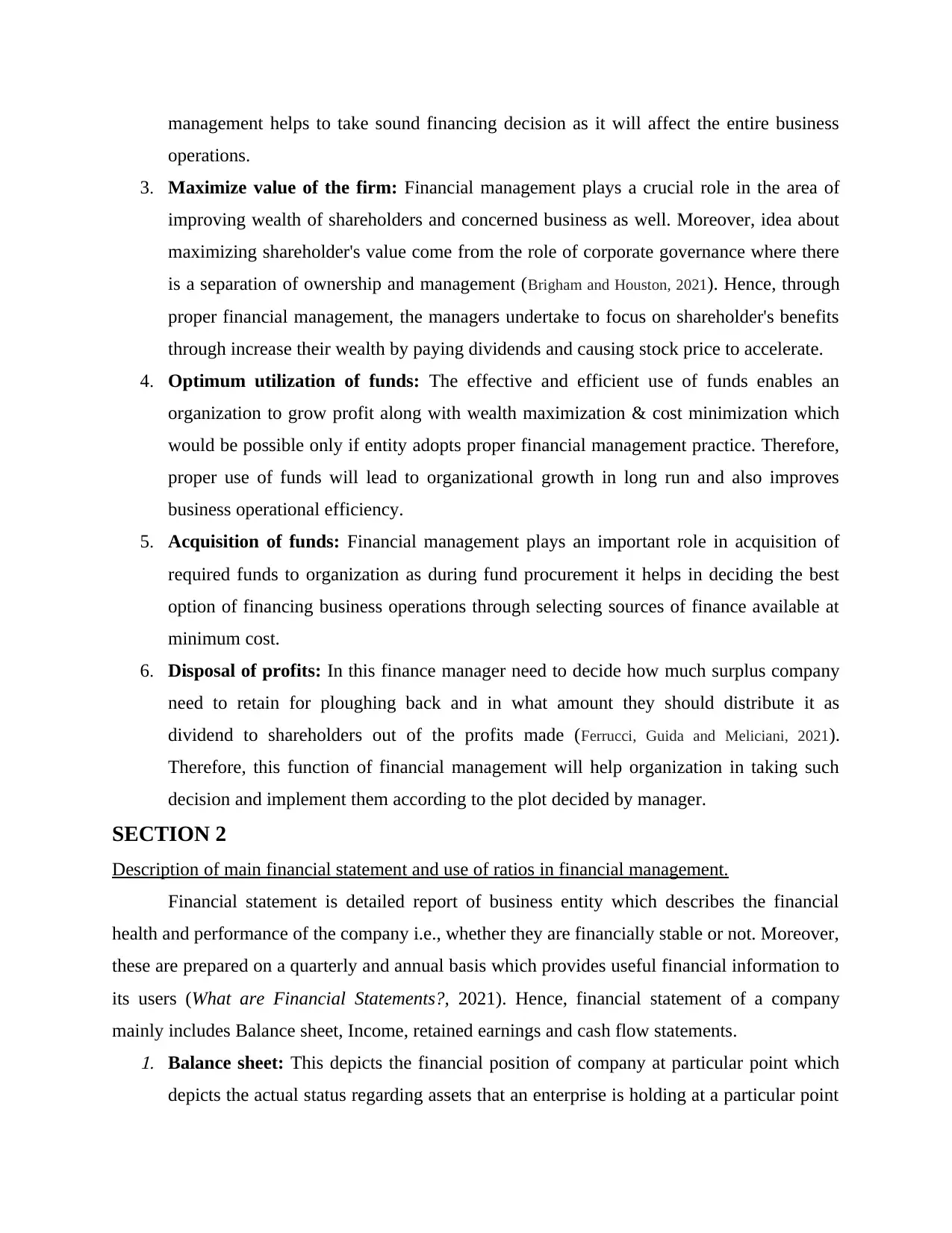
management helps to take sound financing decision as it will affect the entire business
operations.
3. Maximize value of the firm: Financial management plays a crucial role in the area of
improving wealth of shareholders and concerned business as well. Moreover, idea about
maximizing shareholder's value come from the role of corporate governance where there
is a separation of ownership and management (Brigham and Houston, 2021). Hence, through
proper financial management, the managers undertake to focus on shareholder's benefits
through increase their wealth by paying dividends and causing stock price to accelerate.
4. Optimum utilization of funds: The effective and efficient use of funds enables an
organization to grow profit along with wealth maximization & cost minimization which
would be possible only if entity adopts proper financial management practice. Therefore,
proper use of funds will lead to organizational growth in long run and also improves
business operational efficiency.
5. Acquisition of funds: Financial management plays an important role in acquisition of
required funds to organization as during fund procurement it helps in deciding the best
option of financing business operations through selecting sources of finance available at
minimum cost.
6. Disposal of profits: In this finance manager need to decide how much surplus company
need to retain for ploughing back and in what amount they should distribute it as
dividend to shareholders out of the profits made (Ferrucci, Guida and Meliciani, 2021).
Therefore, this function of financial management will help organization in taking such
decision and implement them according to the plot decided by manager.
SECTION 2
Description of main financial statement and use of ratios in financial management.
Financial statement is detailed report of business entity which describes the financial
health and performance of the company i.e., whether they are financially stable or not. Moreover,
these are prepared on a quarterly and annual basis which provides useful financial information to
its users (What are Financial Statements?, 2021). Hence, financial statement of a company
mainly includes Balance sheet, Income, retained earnings and cash flow statements.1. Balance sheet: This depicts the financial position of company at particular point which
depicts the actual status regarding assets that an enterprise is holding at a particular point
operations.
3. Maximize value of the firm: Financial management plays a crucial role in the area of
improving wealth of shareholders and concerned business as well. Moreover, idea about
maximizing shareholder's value come from the role of corporate governance where there
is a separation of ownership and management (Brigham and Houston, 2021). Hence, through
proper financial management, the managers undertake to focus on shareholder's benefits
through increase their wealth by paying dividends and causing stock price to accelerate.
4. Optimum utilization of funds: The effective and efficient use of funds enables an
organization to grow profit along with wealth maximization & cost minimization which
would be possible only if entity adopts proper financial management practice. Therefore,
proper use of funds will lead to organizational growth in long run and also improves
business operational efficiency.
5. Acquisition of funds: Financial management plays an important role in acquisition of
required funds to organization as during fund procurement it helps in deciding the best
option of financing business operations through selecting sources of finance available at
minimum cost.
6. Disposal of profits: In this finance manager need to decide how much surplus company
need to retain for ploughing back and in what amount they should distribute it as
dividend to shareholders out of the profits made (Ferrucci, Guida and Meliciani, 2021).
Therefore, this function of financial management will help organization in taking such
decision and implement them according to the plot decided by manager.
SECTION 2
Description of main financial statement and use of ratios in financial management.
Financial statement is detailed report of business entity which describes the financial
health and performance of the company i.e., whether they are financially stable or not. Moreover,
these are prepared on a quarterly and annual basis which provides useful financial information to
its users (What are Financial Statements?, 2021). Hence, financial statement of a company
mainly includes Balance sheet, Income, retained earnings and cash flow statements.1. Balance sheet: This depicts the financial position of company at particular point which
depicts the actual status regarding assets that an enterprise is holding at a particular point
Paraphrase This Document
Need a fresh take? Get an instant paraphrase of this document with our AI Paraphraser
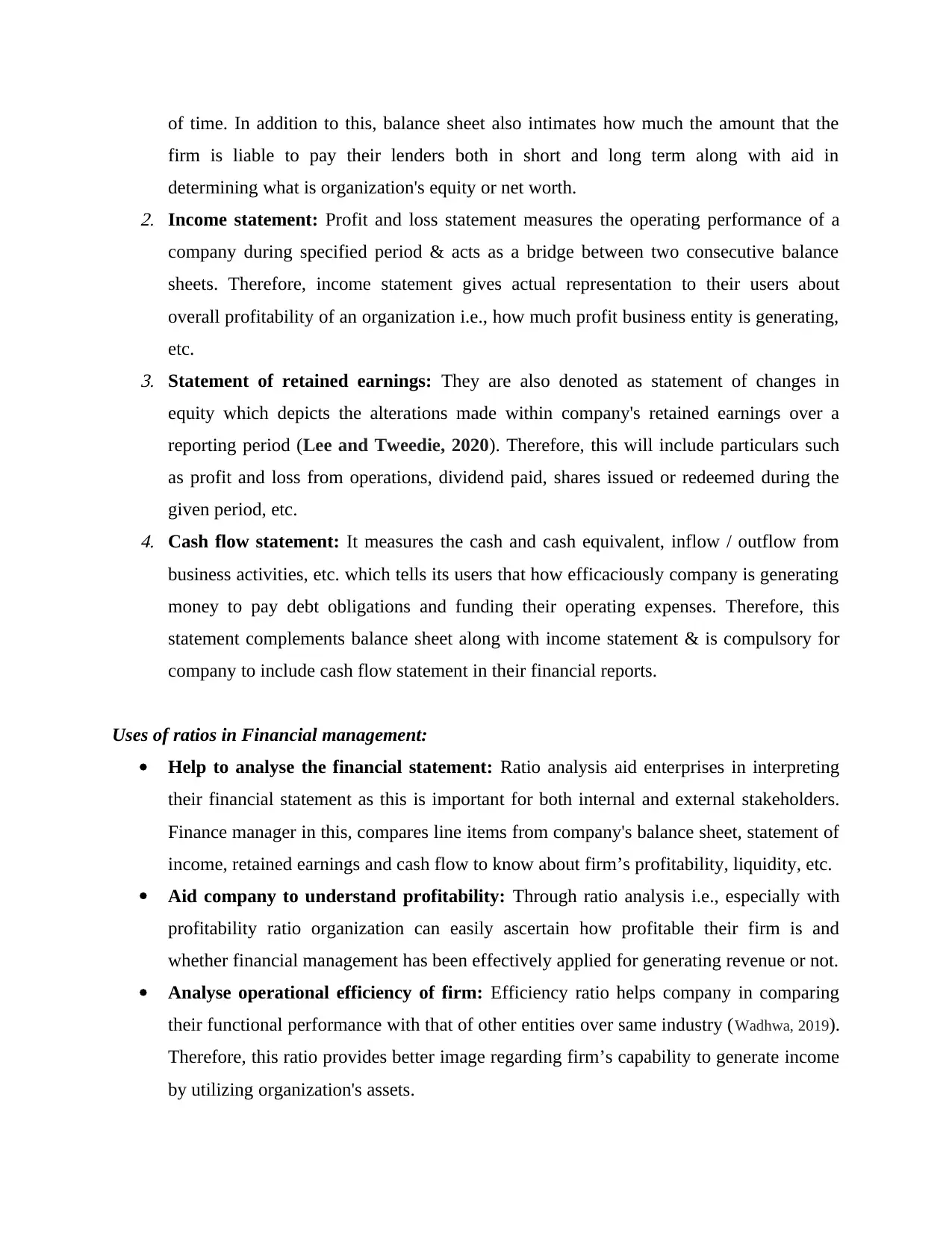
of time. In addition to this, balance sheet also intimates how much the amount that the
firm is liable to pay their lenders both in short and long term along with aid in
determining what is organization's equity or net worth.2. Income statement: Profit and loss statement measures the operating performance of a
company during specified period & acts as a bridge between two consecutive balance
sheets. Therefore, income statement gives actual representation to their users about
overall profitability of an organization i.e., how much profit business entity is generating,
etc.3. Statement of retained earnings: They are also denoted as statement of changes in
equity which depicts the alterations made within company's retained earnings over a
reporting period (Lee and Tweedie, 2020). Therefore, this will include particulars such
as profit and loss from operations, dividend paid, shares issued or redeemed during the
given period, etc.4. Cash flow statement: It measures the cash and cash equivalent, inflow / outflow from
business activities, etc. which tells its users that how efficaciously company is generating
money to pay debt obligations and funding their operating expenses. Therefore, this
statement complements balance sheet along with income statement & is compulsory for
company to include cash flow statement in their financial reports.
Uses of ratios in Financial management:
Help to analyse the financial statement: Ratio analysis aid enterprises in interpreting
their financial statement as this is important for both internal and external stakeholders.
Finance manager in this, compares line items from company's balance sheet, statement of
income, retained earnings and cash flow to know about firm’s profitability, liquidity, etc.
Aid company to understand profitability: Through ratio analysis i.e., especially with
profitability ratio organization can easily ascertain how profitable their firm is and
whether financial management has been effectively applied for generating revenue or not.
Analyse operational efficiency of firm: Efficiency ratio helps company in comparing
their functional performance with that of other entities over same industry (Wadhwa, 2019).
Therefore, this ratio provides better image regarding firm’s capability to generate income
by utilizing organization's assets.
firm is liable to pay their lenders both in short and long term along with aid in
determining what is organization's equity or net worth.2. Income statement: Profit and loss statement measures the operating performance of a
company during specified period & acts as a bridge between two consecutive balance
sheets. Therefore, income statement gives actual representation to their users about
overall profitability of an organization i.e., how much profit business entity is generating,
etc.3. Statement of retained earnings: They are also denoted as statement of changes in
equity which depicts the alterations made within company's retained earnings over a
reporting period (Lee and Tweedie, 2020). Therefore, this will include particulars such
as profit and loss from operations, dividend paid, shares issued or redeemed during the
given period, etc.4. Cash flow statement: It measures the cash and cash equivalent, inflow / outflow from
business activities, etc. which tells its users that how efficaciously company is generating
money to pay debt obligations and funding their operating expenses. Therefore, this
statement complements balance sheet along with income statement & is compulsory for
company to include cash flow statement in their financial reports.
Uses of ratios in Financial management:
Help to analyse the financial statement: Ratio analysis aid enterprises in interpreting
their financial statement as this is important for both internal and external stakeholders.
Finance manager in this, compares line items from company's balance sheet, statement of
income, retained earnings and cash flow to know about firm’s profitability, liquidity, etc.
Aid company to understand profitability: Through ratio analysis i.e., especially with
profitability ratio organization can easily ascertain how profitable their firm is and
whether financial management has been effectively applied for generating revenue or not.
Analyse operational efficiency of firm: Efficiency ratio helps company in comparing
their functional performance with that of other entities over same industry (Wadhwa, 2019).
Therefore, this ratio provides better image regarding firm’s capability to generate income
by utilizing organization's assets.
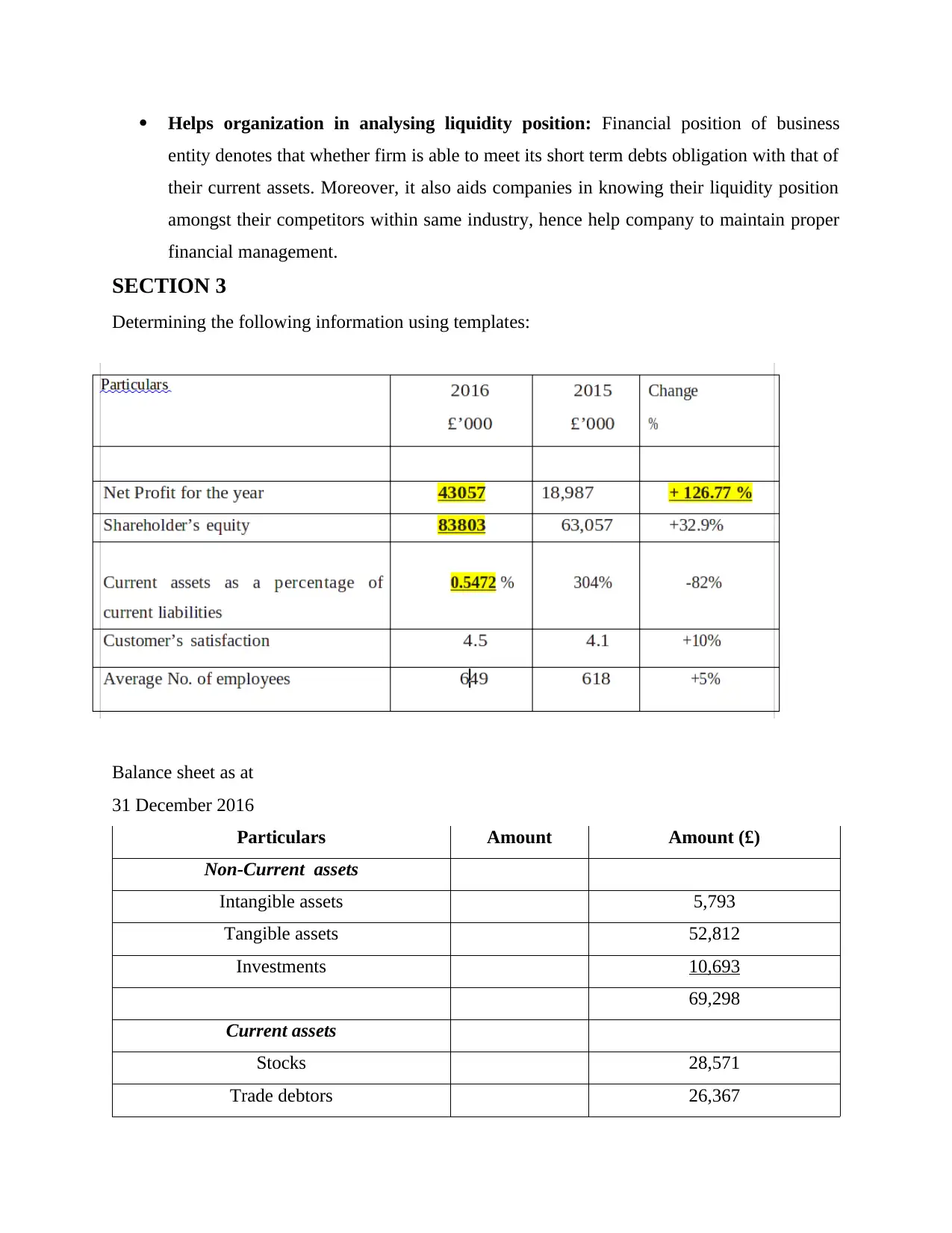
Helps organization in analysing liquidity position: Financial position of business
entity denotes that whether firm is able to meet its short term debts obligation with that of
their current assets. Moreover, it also aids companies in knowing their liquidity position
amongst their competitors within same industry, hence help company to maintain proper
financial management.
SECTION 3
Determining the following information using templates:
Balance sheet as at
31 December 2016
Particulars Amount Amount (£)
Non-Current assets
Intangible assets 5,793
Tangible assets 52,812
Investments 10,693
69,298
Current assets
Stocks 28,571
Trade debtors 26,367
entity denotes that whether firm is able to meet its short term debts obligation with that of
their current assets. Moreover, it also aids companies in knowing their liquidity position
amongst their competitors within same industry, hence help company to maintain proper
financial management.
SECTION 3
Determining the following information using templates:
Balance sheet as at
31 December 2016
Particulars Amount Amount (£)
Non-Current assets
Intangible assets 5,793
Tangible assets 52,812
Investments 10,693
69,298
Current assets
Stocks 28,571
Trade debtors 26,367
⊘ This is a preview!⊘
Do you want full access?
Subscribe today to unlock all pages.

Trusted by 1+ million students worldwide
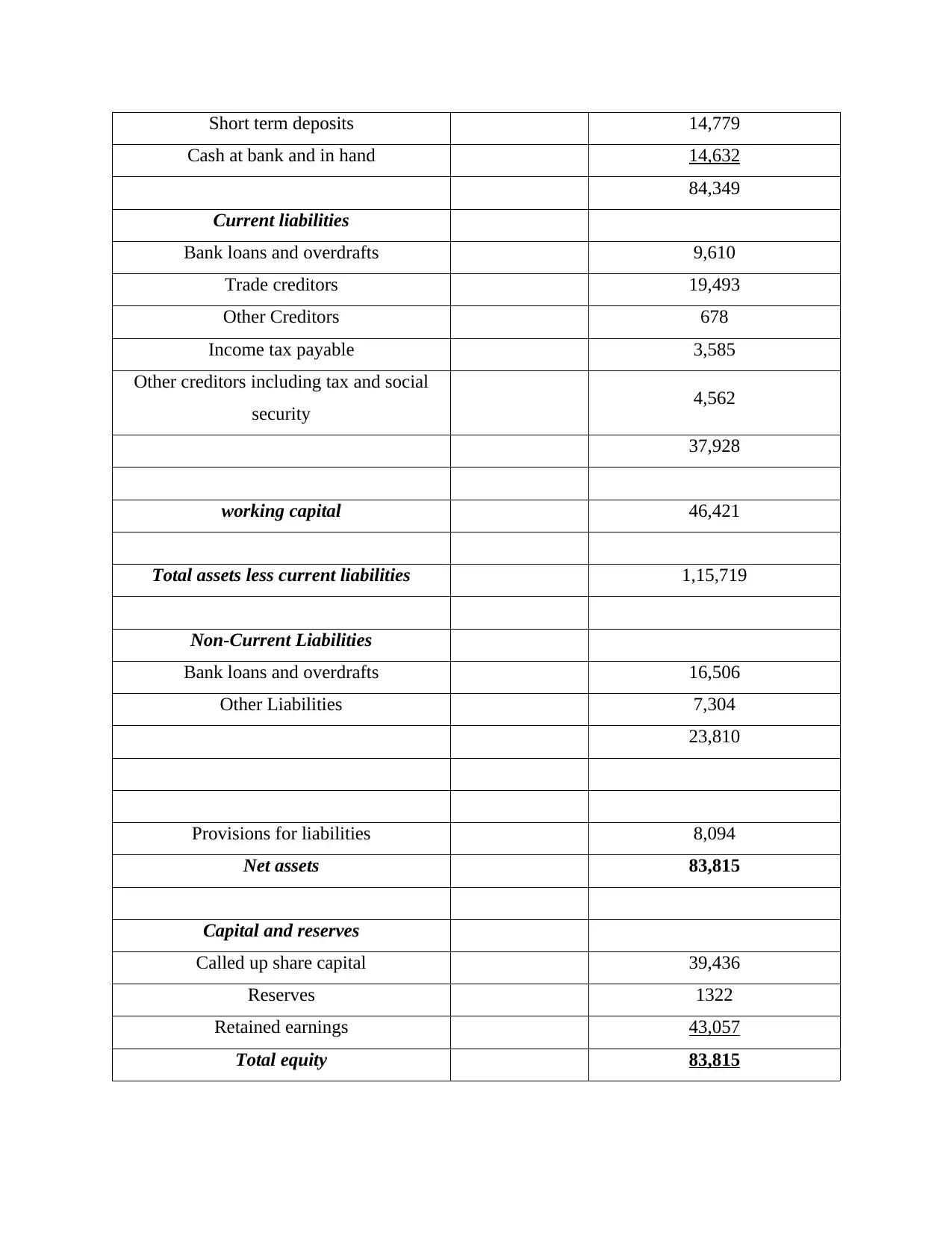
Short term deposits 14,779
Cash at bank and in hand 14,632
84,349
Current liabilities
Bank loans and overdrafts 9,610
Trade creditors 19,493
Other Creditors 678
Income tax payable 3,585
Other creditors including tax and social
security 4,562
37,928
working capital 46,421
Total assets less current liabilities 1,15,719
Non-Current Liabilities
Bank loans and overdrafts 16,506
Other Liabilities 7,304
23,810
Provisions for liabilities 8,094
Net assets 83,815
Capital and reserves
Called up share capital 39,436
Reserves 1322
Retained earnings 43,057
Total equity 83,815
Cash at bank and in hand 14,632
84,349
Current liabilities
Bank loans and overdrafts 9,610
Trade creditors 19,493
Other Creditors 678
Income tax payable 3,585
Other creditors including tax and social
security 4,562
37,928
working capital 46,421
Total assets less current liabilities 1,15,719
Non-Current Liabilities
Bank loans and overdrafts 16,506
Other Liabilities 7,304
23,810
Provisions for liabilities 8,094
Net assets 83,815
Capital and reserves
Called up share capital 39,436
Reserves 1322
Retained earnings 43,057
Total equity 83,815
Paraphrase This Document
Need a fresh take? Get an instant paraphrase of this document with our AI Paraphraser
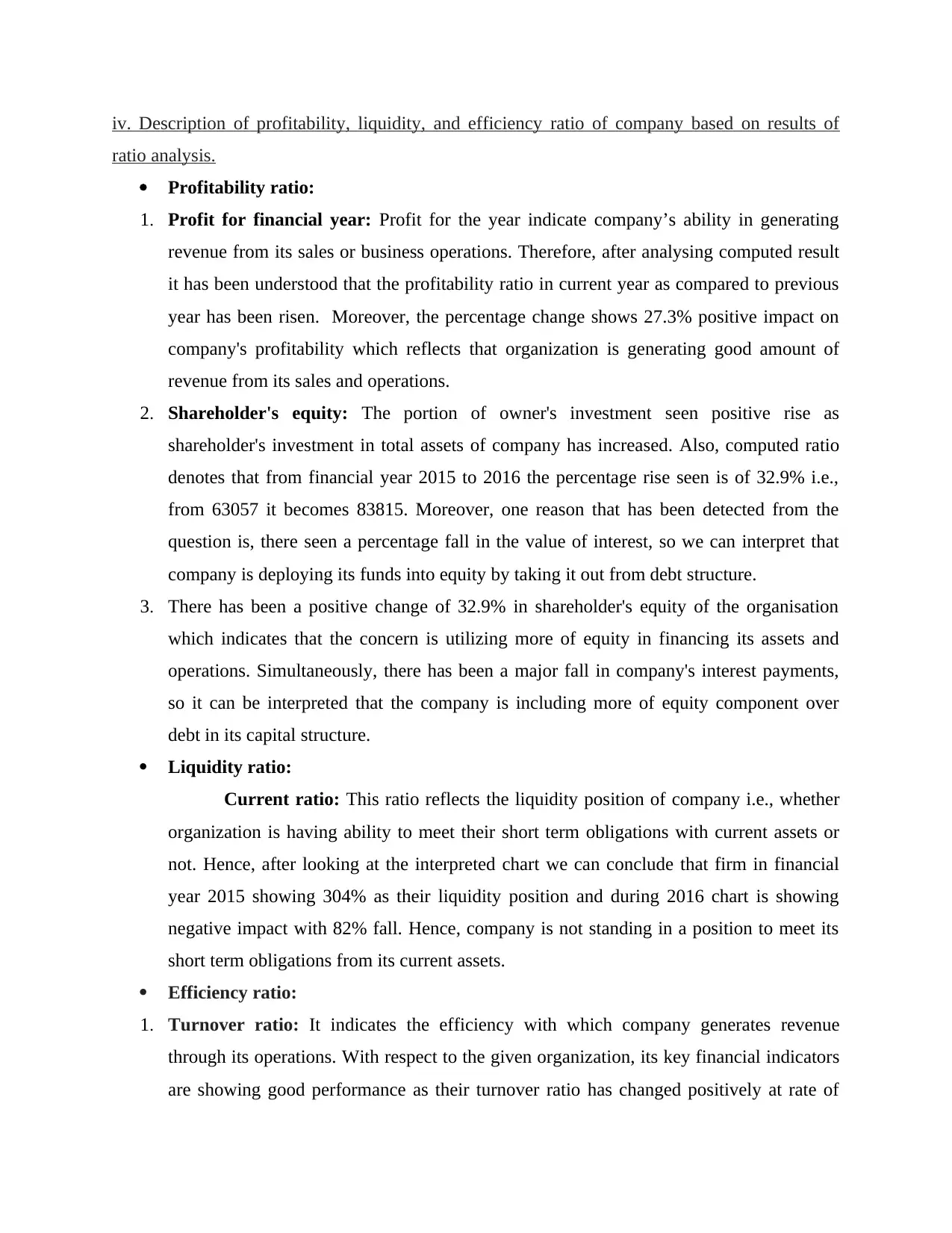
iv. Description of profitability, liquidity, and efficiency ratio of company based on results of
ratio analysis.
Profitability ratio:
1. Profit for financial year: Profit for the year indicate company’s ability in generating
revenue from its sales or business operations. Therefore, after analysing computed result
it has been understood that the profitability ratio in current year as compared to previous
year has been risen. Moreover, the percentage change shows 27.3% positive impact on
company's profitability which reflects that organization is generating good amount of
revenue from its sales and operations.
2. Shareholder's equity: The portion of owner's investment seen positive rise as
shareholder's investment in total assets of company has increased. Also, computed ratio
denotes that from financial year 2015 to 2016 the percentage rise seen is of 32.9% i.e.,
from 63057 it becomes 83815. Moreover, one reason that has been detected from the
question is, there seen a percentage fall in the value of interest, so we can interpret that
company is deploying its funds into equity by taking it out from debt structure.
3. There has been a positive change of 32.9% in shareholder's equity of the organisation
which indicates that the concern is utilizing more of equity in financing its assets and
operations. Simultaneously, there has been a major fall in company's interest payments,
so it can be interpreted that the company is including more of equity component over
debt in its capital structure.
Liquidity ratio:
Current ratio: This ratio reflects the liquidity position of company i.e., whether
organization is having ability to meet their short term obligations with current assets or
not. Hence, after looking at the interpreted chart we can conclude that firm in financial
year 2015 showing 304% as their liquidity position and during 2016 chart is showing
negative impact with 82% fall. Hence, company is not standing in a position to meet its
short term obligations from its current assets.
Efficiency ratio:
1. Turnover ratio: It indicates the efficiency with which company generates revenue
through its operations. With respect to the given organization, its key financial indicators
are showing good performance as their turnover ratio has changed positively at rate of
ratio analysis.
Profitability ratio:
1. Profit for financial year: Profit for the year indicate company’s ability in generating
revenue from its sales or business operations. Therefore, after analysing computed result
it has been understood that the profitability ratio in current year as compared to previous
year has been risen. Moreover, the percentage change shows 27.3% positive impact on
company's profitability which reflects that organization is generating good amount of
revenue from its sales and operations.
2. Shareholder's equity: The portion of owner's investment seen positive rise as
shareholder's investment in total assets of company has increased. Also, computed ratio
denotes that from financial year 2015 to 2016 the percentage rise seen is of 32.9% i.e.,
from 63057 it becomes 83815. Moreover, one reason that has been detected from the
question is, there seen a percentage fall in the value of interest, so we can interpret that
company is deploying its funds into equity by taking it out from debt structure.
3. There has been a positive change of 32.9% in shareholder's equity of the organisation
which indicates that the concern is utilizing more of equity in financing its assets and
operations. Simultaneously, there has been a major fall in company's interest payments,
so it can be interpreted that the company is including more of equity component over
debt in its capital structure.
Liquidity ratio:
Current ratio: This ratio reflects the liquidity position of company i.e., whether
organization is having ability to meet their short term obligations with current assets or
not. Hence, after looking at the interpreted chart we can conclude that firm in financial
year 2015 showing 304% as their liquidity position and during 2016 chart is showing
negative impact with 82% fall. Hence, company is not standing in a position to meet its
short term obligations from its current assets.
Efficiency ratio:
1. Turnover ratio: It indicates the efficiency with which company generates revenue
through its operations. With respect to the given organization, its key financial indicators
are showing good performance as their turnover ratio has changed positively at rate of
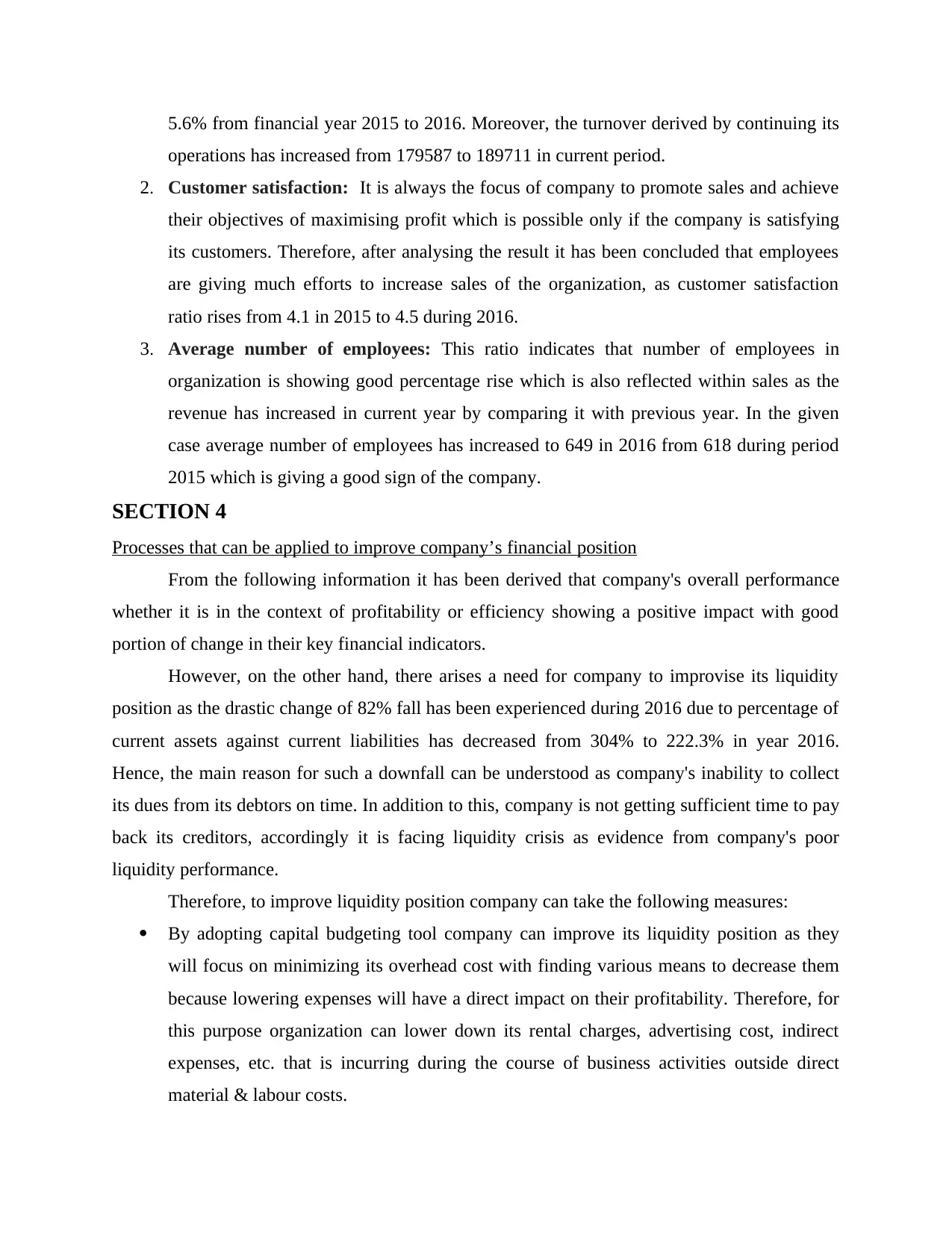
5.6% from financial year 2015 to 2016. Moreover, the turnover derived by continuing its
operations has increased from 179587 to 189711 in current period.
2. Customer satisfaction: It is always the focus of company to promote sales and achieve
their objectives of maximising profit which is possible only if the company is satisfying
its customers. Therefore, after analysing the result it has been concluded that employees
are giving much efforts to increase sales of the organization, as customer satisfaction
ratio rises from 4.1 in 2015 to 4.5 during 2016.
3. Average number of employees: This ratio indicates that number of employees in
organization is showing good percentage rise which is also reflected within sales as the
revenue has increased in current year by comparing it with previous year. In the given
case average number of employees has increased to 649 in 2016 from 618 during period
2015 which is giving a good sign of the company.
SECTION 4
Processes that can be applied to improve company’s financial position
From the following information it has been derived that company's overall performance
whether it is in the context of profitability or efficiency showing a positive impact with good
portion of change in their key financial indicators.
However, on the other hand, there arises a need for company to improvise its liquidity
position as the drastic change of 82% fall has been experienced during 2016 due to percentage of
current assets against current liabilities has decreased from 304% to 222.3% in year 2016.
Hence, the main reason for such a downfall can be understood as company's inability to collect
its dues from its debtors on time. In addition to this, company is not getting sufficient time to pay
back its creditors, accordingly it is facing liquidity crisis as evidence from company's poor
liquidity performance.
Therefore, to improve liquidity position company can take the following measures:
By adopting capital budgeting tool company can improve its liquidity position as they
will focus on minimizing its overhead cost with finding various means to decrease them
because lowering expenses will have a direct impact on their profitability. Therefore, for
this purpose organization can lower down its rental charges, advertising cost, indirect
expenses, etc. that is incurring during the course of business activities outside direct
material & labour costs.
operations has increased from 179587 to 189711 in current period.
2. Customer satisfaction: It is always the focus of company to promote sales and achieve
their objectives of maximising profit which is possible only if the company is satisfying
its customers. Therefore, after analysing the result it has been concluded that employees
are giving much efforts to increase sales of the organization, as customer satisfaction
ratio rises from 4.1 in 2015 to 4.5 during 2016.
3. Average number of employees: This ratio indicates that number of employees in
organization is showing good percentage rise which is also reflected within sales as the
revenue has increased in current year by comparing it with previous year. In the given
case average number of employees has increased to 649 in 2016 from 618 during period
2015 which is giving a good sign of the company.
SECTION 4
Processes that can be applied to improve company’s financial position
From the following information it has been derived that company's overall performance
whether it is in the context of profitability or efficiency showing a positive impact with good
portion of change in their key financial indicators.
However, on the other hand, there arises a need for company to improvise its liquidity
position as the drastic change of 82% fall has been experienced during 2016 due to percentage of
current assets against current liabilities has decreased from 304% to 222.3% in year 2016.
Hence, the main reason for such a downfall can be understood as company's inability to collect
its dues from its debtors on time. In addition to this, company is not getting sufficient time to pay
back its creditors, accordingly it is facing liquidity crisis as evidence from company's poor
liquidity performance.
Therefore, to improve liquidity position company can take the following measures:
By adopting capital budgeting tool company can improve its liquidity position as they
will focus on minimizing its overhead cost with finding various means to decrease them
because lowering expenses will have a direct impact on their profitability. Therefore, for
this purpose organization can lower down its rental charges, advertising cost, indirect
expenses, etc. that is incurring during the course of business activities outside direct
material & labour costs.
⊘ This is a preview!⊘
Do you want full access?
Subscribe today to unlock all pages.

Trusted by 1+ million students worldwide
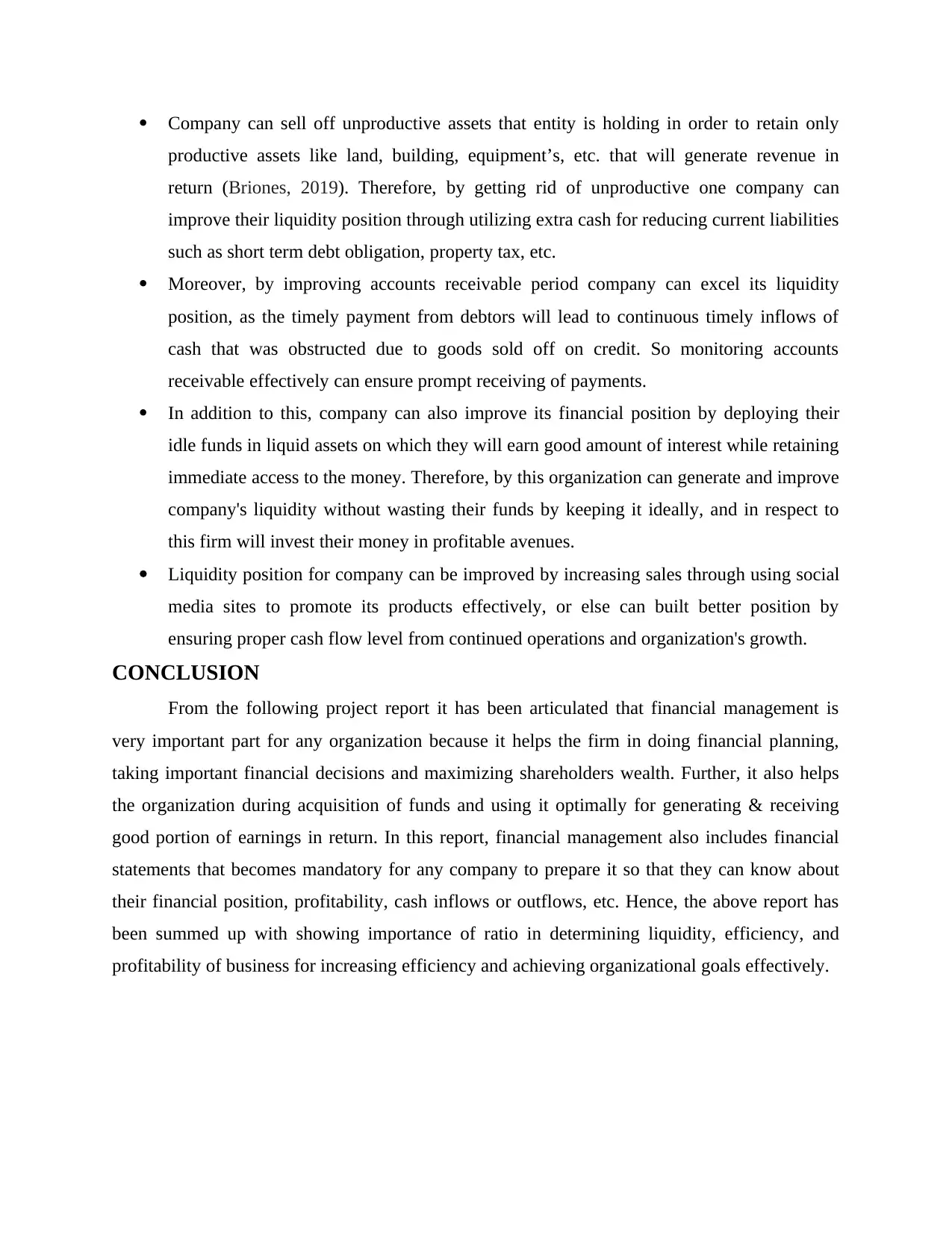
Company can sell off unproductive assets that entity is holding in order to retain only
productive assets like land, building, equipment’s, etc. that will generate revenue in
return (Briones, 2019). Therefore, by getting rid of unproductive one company can
improve their liquidity position through utilizing extra cash for reducing current liabilities
such as short term debt obligation, property tax, etc.
Moreover, by improving accounts receivable period company can excel its liquidity
position, as the timely payment from debtors will lead to continuous timely inflows of
cash that was obstructed due to goods sold off on credit. So monitoring accounts
receivable effectively can ensure prompt receiving of payments.
In addition to this, company can also improve its financial position by deploying their
idle funds in liquid assets on which they will earn good amount of interest while retaining
immediate access to the money. Therefore, by this organization can generate and improve
company's liquidity without wasting their funds by keeping it ideally, and in respect to
this firm will invest their money in profitable avenues.
Liquidity position for company can be improved by increasing sales through using social
media sites to promote its products effectively, or else can built better position by
ensuring proper cash flow level from continued operations and organization's growth.
CONCLUSION
From the following project report it has been articulated that financial management is
very important part for any organization because it helps the firm in doing financial planning,
taking important financial decisions and maximizing shareholders wealth. Further, it also helps
the organization during acquisition of funds and using it optimally for generating & receiving
good portion of earnings in return. In this report, financial management also includes financial
statements that becomes mandatory for any company to prepare it so that they can know about
their financial position, profitability, cash inflows or outflows, etc. Hence, the above report has
been summed up with showing importance of ratio in determining liquidity, efficiency, and
profitability of business for increasing efficiency and achieving organizational goals effectively.
productive assets like land, building, equipment’s, etc. that will generate revenue in
return (Briones, 2019). Therefore, by getting rid of unproductive one company can
improve their liquidity position through utilizing extra cash for reducing current liabilities
such as short term debt obligation, property tax, etc.
Moreover, by improving accounts receivable period company can excel its liquidity
position, as the timely payment from debtors will lead to continuous timely inflows of
cash that was obstructed due to goods sold off on credit. So monitoring accounts
receivable effectively can ensure prompt receiving of payments.
In addition to this, company can also improve its financial position by deploying their
idle funds in liquid assets on which they will earn good amount of interest while retaining
immediate access to the money. Therefore, by this organization can generate and improve
company's liquidity without wasting their funds by keeping it ideally, and in respect to
this firm will invest their money in profitable avenues.
Liquidity position for company can be improved by increasing sales through using social
media sites to promote its products effectively, or else can built better position by
ensuring proper cash flow level from continued operations and organization's growth.
CONCLUSION
From the following project report it has been articulated that financial management is
very important part for any organization because it helps the firm in doing financial planning,
taking important financial decisions and maximizing shareholders wealth. Further, it also helps
the organization during acquisition of funds and using it optimally for generating & receiving
good portion of earnings in return. In this report, financial management also includes financial
statements that becomes mandatory for any company to prepare it so that they can know about
their financial position, profitability, cash inflows or outflows, etc. Hence, the above report has
been summed up with showing importance of ratio in determining liquidity, efficiency, and
profitability of business for increasing efficiency and achieving organizational goals effectively.
Paraphrase This Document
Need a fresh take? Get an instant paraphrase of this document with our AI Paraphraser
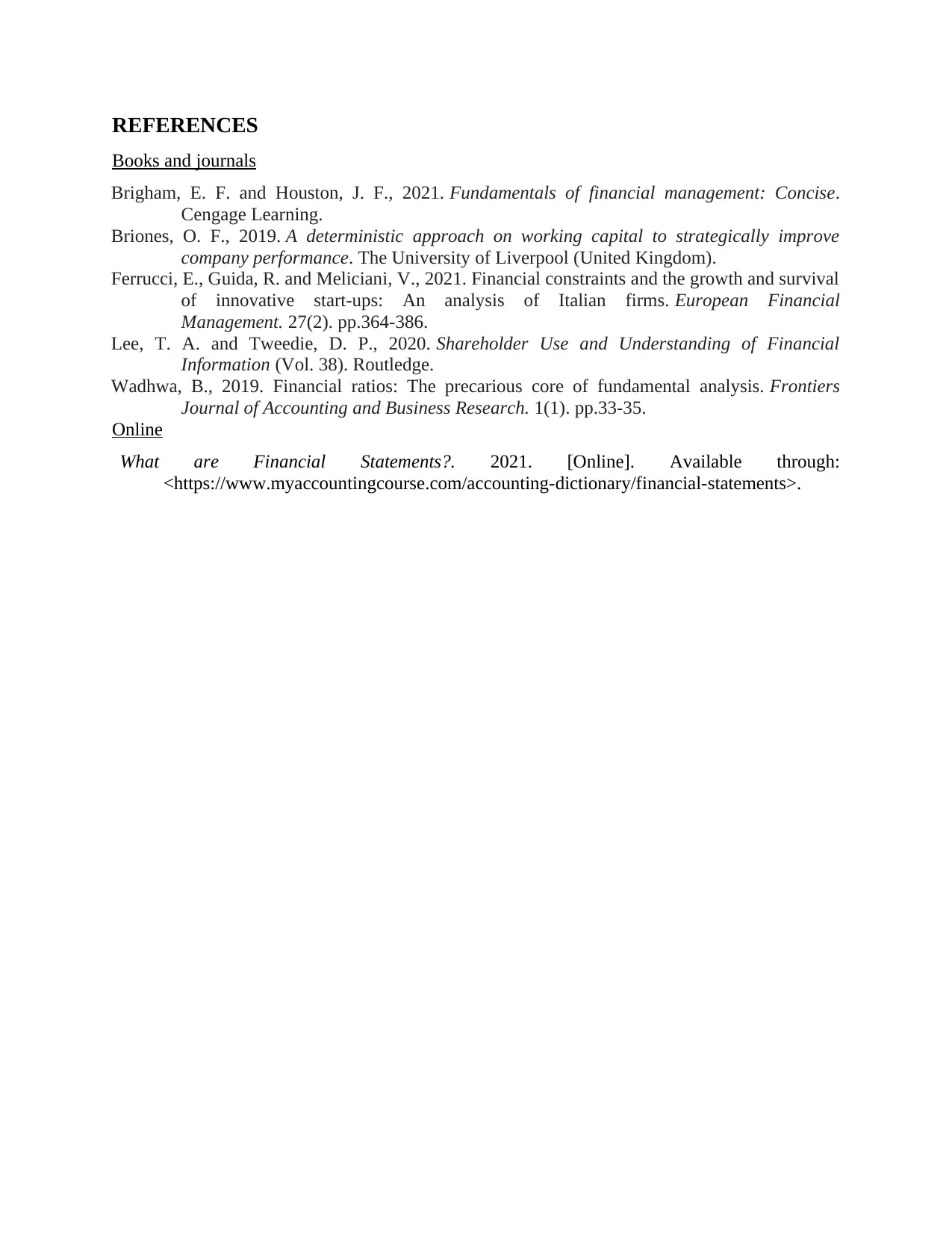
REFERENCES
Books and journals
Brigham, E. F. and Houston, J. F., 2021. Fundamentals of financial management: Concise.
Cengage Learning.
Briones, O. F., 2019. A deterministic approach on working capital to strategically improve
company performance. The University of Liverpool (United Kingdom).
Ferrucci, E., Guida, R. and Meliciani, V., 2021. Financial constraints and the growth and survival
of innovative start‐ups: An analysis of Italian firms. European Financial
Management. 27(2). pp.364-386.
Lee, T. A. and Tweedie, D. P., 2020. Shareholder Use and Understanding of Financial
Information (Vol. 38). Routledge.
Wadhwa, B., 2019. Financial ratios: The precarious core of fundamental analysis. Frontiers
Journal of Accounting and Business Research. 1(1). pp.33-35.
Online
What are Financial Statements?. 2021. [Online]. Available through:
<https://www.myaccountingcourse.com/accounting-dictionary/financial-statements>.
Books and journals
Brigham, E. F. and Houston, J. F., 2021. Fundamentals of financial management: Concise.
Cengage Learning.
Briones, O. F., 2019. A deterministic approach on working capital to strategically improve
company performance. The University of Liverpool (United Kingdom).
Ferrucci, E., Guida, R. and Meliciani, V., 2021. Financial constraints and the growth and survival
of innovative start‐ups: An analysis of Italian firms. European Financial
Management. 27(2). pp.364-386.
Lee, T. A. and Tweedie, D. P., 2020. Shareholder Use and Understanding of Financial
Information (Vol. 38). Routledge.
Wadhwa, B., 2019. Financial ratios: The precarious core of fundamental analysis. Frontiers
Journal of Accounting and Business Research. 1(1). pp.33-35.
Online
What are Financial Statements?. 2021. [Online]. Available through:
<https://www.myaccountingcourse.com/accounting-dictionary/financial-statements>.
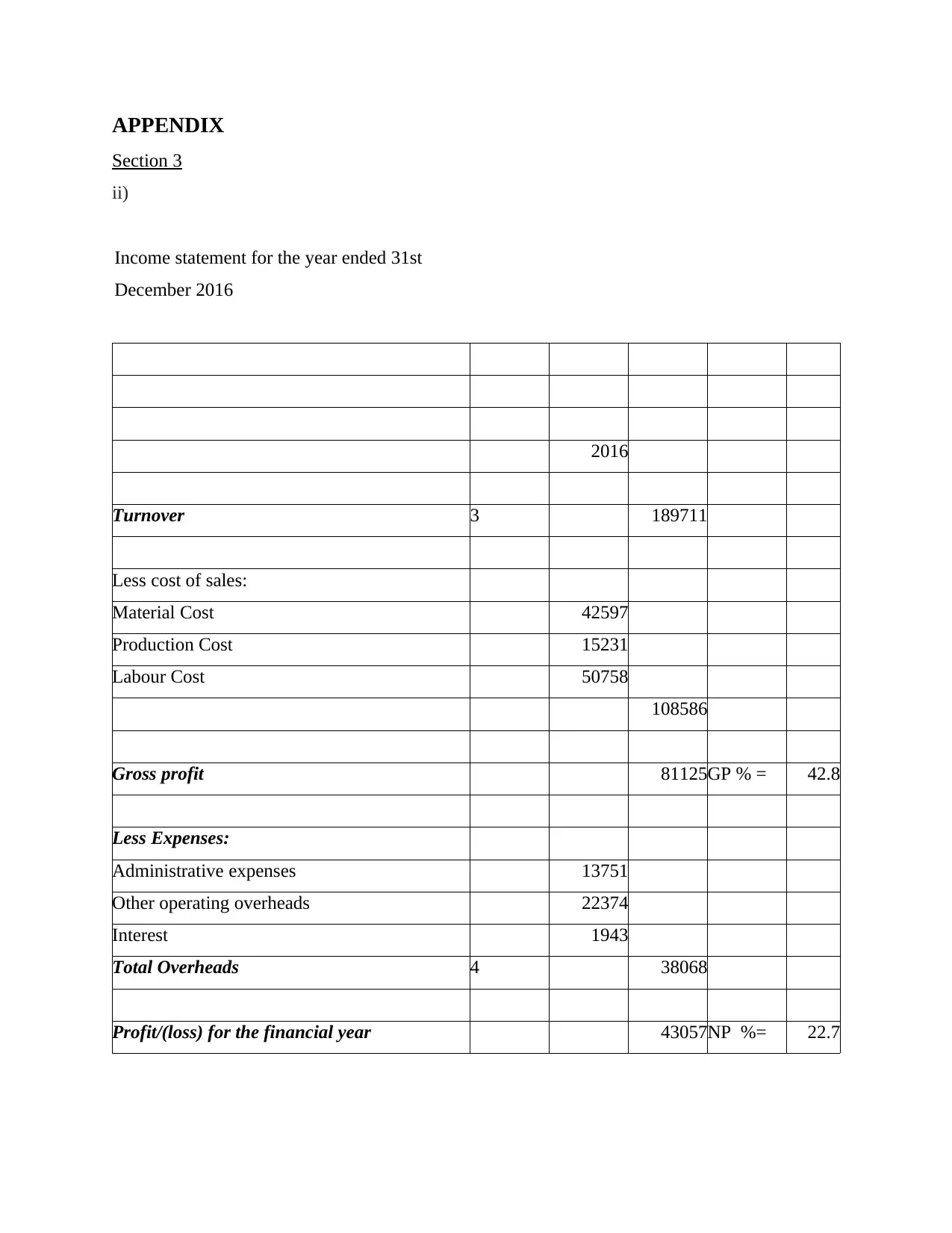
APPENDIX
Section 3
ii)
Income statement for the year ended 31st
December 2016
2016
Turnover 3 189711
Less cost of sales:
Material Cost 42597
Production Cost 15231
Labour Cost 50758
108586
Gross profit 81125GP % = 42.8
Less Expenses:
Administrative expenses 13751
Other operating overheads 22374
Interest 1943
Total Overheads 4 38068
Profit/(loss) for the financial year 43057NP %= 22.7
Section 3
ii)
Income statement for the year ended 31st
December 2016
2016
Turnover 3 189711
Less cost of sales:
Material Cost 42597
Production Cost 15231
Labour Cost 50758
108586
Gross profit 81125GP % = 42.8
Less Expenses:
Administrative expenses 13751
Other operating overheads 22374
Interest 1943
Total Overheads 4 38068
Profit/(loss) for the financial year 43057NP %= 22.7
⊘ This is a preview!⊘
Do you want full access?
Subscribe today to unlock all pages.

Trusted by 1+ million students worldwide
1 out of 13
Related Documents
Your All-in-One AI-Powered Toolkit for Academic Success.
+13062052269
info@desklib.com
Available 24*7 on WhatsApp / Email
![[object Object]](/_next/static/media/star-bottom.7253800d.svg)
Unlock your academic potential
Copyright © 2020–2025 A2Z Services. All Rights Reserved. Developed and managed by ZUCOL.





